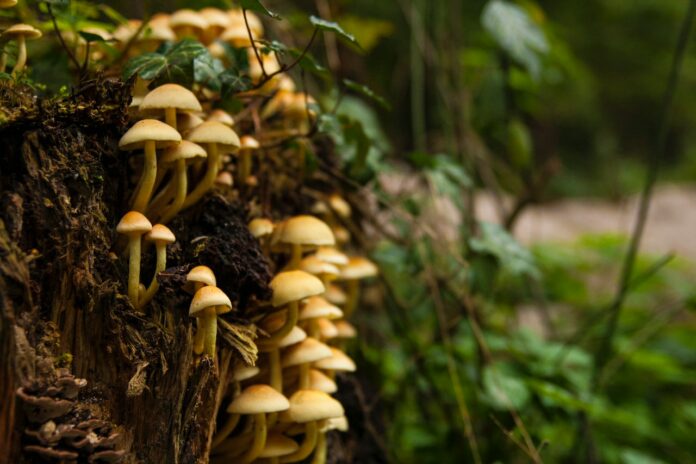In mycology, the study of fungi, few species captivate the imagination and spark curiosity quite like magic mushrooms, also known as psilocybin mushrooms. These enigmatic fungi, celebrated for their psychoactive properties, have been intertwined with human culture and spirituality for centuries. The cultivation of magic mushrooms is a fascinating intersection of science, nature, and human curiosity. This article delves into the mystical mycology behind the science of magic mushroom cultivation. Also, we will talk about Golden Teacher Magic Mushroom Kit:
The Enigmatic Appeal of Magic Mushrooms
Before we explore the science of cultivating magic mushrooms, it’s essential to understand what makes these fungi so captivating. Magic mushrooms belong to the Psilocybe genus and contain psychoactive compounds, primarily psilocybin and psilocin. When ingested, these compounds can induce profound alterations in perception, thought, and consciousness. This psychedelic experience has led to their use in various cultural and spiritual practices and recreational exploration. There are magic mushroom grow kits available that are used to cultivate shrooms at home. It is a product that empowers individuals to cultivate their own psilocybin mushrooms within the confines of their homes. This kit contains all the essentials needed for a successful mushroom-growing journey. Inside every ShroomBox, you’ll find a box filled with a carefully prepared substrate.
This substrate is not just any ordinary soil but a blend of organic materials teeming with potential. It is already inoculated with mushroom spores and the all-important mycelium, the vegetative part of the fungus responsible for producing the magical mushrooms. Now, people use Golden Teachers are an ideal choice for those new to the world of psychedelic mushrooms. These fungi provide a mild-to-high psychotropic experience that’s generally well-tolerated, even at higher doses.
Cultivating the Magic: The Science Behind It
Cultivating magic mushrooms is an art that combines biology, chemistry, and environmental science. Here are the key scientific aspects of magic mushroom cultivation:
1. Strain Selection
Cultivation begins with selecting the strain of magic mushrooms you want to grow. Different strains exhibit variations in potency, growth characteristics, and appearance. Common strains like Psilocybe cubensis, Golden Teacher, and Ecuadorian are popular choices among cultivators. The selection of a strain sets the stage for the entire cultivation process.
2. Substrate and Nutrition
The heart of mushroom cultivation lies in the substrate—the medium in which the mycelium, the vegetative part of the fungus, thrives. Substrates typically consist of organic materials, such as vermiculite, brown rice flour, and water. These ingredients provide the necessary nutrients for mycelial growth.
3. Inoculation
Inoculation is the process of introducing mushroom spores or mycelium into the substrate. It initiates the colonization of the substrate by the mycelium, setting the stage for the formation of mushrooms. The goal is to ensure the substrate is evenly colonized, essential for a successful harvest.
4. Environmental Conditions
Creating the ideal environment for mushroom growth is crucial. Temperature, humidity, and light conditions must be carefully controlled. Most magic mushrooms thrive at temperatures between 18°C to 28°C (64°F to 82°F). Maintaining high humidity levels is also critical, particularly during the fruiting stage when mushrooms develop.
5. Fruiting Process
The fruiting stage is when the magic happens—literally. This is when the mycelium transforms into the mushrooms we recognize. During this phase, proper ventilation and air exchange are essential, as they facilitate the growth of the mushroom caps and prevent contaminants.
6. Harvesting
Harvesting magic mushrooms requires a gentle touch. Mushrooms should be picked when the caps are fully developed and just before they begin to open and reveal their gills. It’s crucial to avoid damaging the substrate during this process.
7. Multiple Flushes
Many magic mushroom strains can produce multiple flushes or cycles of mushroom growth. Each flush yields fewer mushrooms than the previous one but extends the harvest period. Cultivators often plan for successive flushes to maximize their yield.
The Potential for Scientific Exploration
Magic mushroom cultivation isn’t merely an artistic pursuit—it also presents opportunities for scientific exploration. Researchers have been investigating the therapeutic potential of psilocybin, the primary psychoactive compound found in magic mushrooms, for conditions such as depression, anxiety, and PTSD. Cultivating magic mushrooms provides a controlled and consistent source of psilocybin for scientific studies, contributing to our understanding of their potential benefits.
Conclusion
The cultivation of magic mushrooms is a captivating blend of science, nature, and human curiosity. It’s an art that combines biology, chemistry, and environmental science to unlock the mystical properties of these fungi. As attitudes toward magic mushrooms continue to evolve, both culturally and scientifically, the field of mystical mycology offers an exciting avenue for exploration and discovery. Whether for personal use, scientific study, or simply the joy of nurturing nature’s mysteries, cultivating magic mushrooms remains a profound and enchanting journey.












